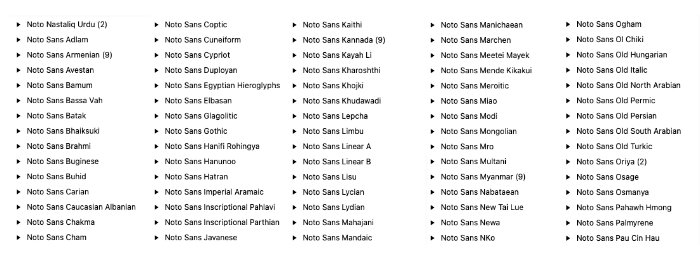How to remove Noto Sans
Tired of scrolling through long lists of fonts you’ll never use? Use Typeface to hide macOS system fonts and clean up your font pickers.
⚠️ Ventura Update: Deactivating supplemental system fonts is not possible anymore in macOS Ventura and later. Apple has disabled this functionality and prevents Typeface from deactivating any system fonts, including the Noto fonts.
If you want to be able to deactivate system fonts to clean up font lists please let Apple know by sending your feedback.
Optional and required macOS system fonts
While designing in Big Sur or Monterey you’ve undoubtedly noticed that there are a lot of system fonts visible in the font pickers. The ‘Noto Sans’ family is most notorious, as it comes with many different variants.

This can be annoying since they are cluttering your font lists and they might even slow down your design apps. Fortunately you can deactivate some of the macOS system fonts using Typeface to clean up the font pickers (only on macOS Big Sur & Monterey).
MacOS comes with several system fonts of which some are required and some are optional. Typeface automatically imports these fonts and you can view them using the System tag. Option click on the User tag in the sidebar to view System fonts.
The default macOS system fonts are located in /System/Library/Fonts. Files located in that folder are required and cannot be deactivated, so these fonts will always be visible in design apps. But fonts in the /System/Library/Fonts/Supplemental subfolder are optional. These supplemental fonts can be hidden by deactivating them in Typeface.
Back to the Noto fonts. If you look at the Typeface System tag you’ll notice it only shows six Noto families: Noto Nastaliq Urdu, Noto Sans Kannada, Noto Sans Myanmar, Noto Sans Oriya, Noto Sans Zawgyi and Noto Serif Myanmar. These six families are all located in /System/Library/Fonts and cannot be deactivated. But your design apps might show a lot more Noto fonts, where are all the other variants?
Document support fonts
Besides regular system fonts which are available in all apps macOS provides some ‘document support’ fonts. These fonts are only available for existing documents (that already use these fonts), or for apps that explicitly request them. I assume these fonts are included for some kind of backwards compatibility and additional language support. They should typically not be used in new documents, so it doesn’t really make sense to display them in font pickers.
Unfortunately many design applications don’t care about that and just show all these fonts in their font picker anyway. Even though it’s probably better to hide them by default, since most users won’t ever have a need for them. But this is the reality, so us designers need to try and work around it…
Hiding supplemental macOS fonts from font pickers
The supplemental macOS ‘document support’ fonts are not visible in Typeface by default. You can manually import them to deactivate them. The /System/Library/Fonts/Supplemental folder contains most of the document support Noto fonts (but not all, some are required). By importing that folder they’ll be visible and deactivatable in Typeface.
Follow these steps to import and hide the Noto fonts and other optional macOS system fonts:
- Open Typeface
- Choose > >
- Click to confirm importing the ’Supplemental’ folder (it will be preselected)
- Deactivate the fonts you want to hide
To deactivate all supplemental fonts right click on the new Supplemental location in the sidebar and choose . Of course you can also manually pick some fonts to deactivate, for more information about deactivating fonts see the activation article.
Once deactivated the fonts should not be visible anymore in your design apps. This is persistent, so even after restarting your Mac the font pickers should stay a bit more clean.
Before you go ahead and deactivate the Noto fonts make sure you’re comfortable deactivating macOS system fonts. Typically I’d recommend to leave all system fonts alone unless you have a very good reason to mess with them. Just to prevent any headaches and problems later on. While I haven’t noticed any issues it might be that some of your apps depend on the fonts. If you notice font rendering problems you can try to activate the fonts again, or completely reset the macOS font cache. That should restore the activation status of the supplemental fonts.
For information about document support fonts and other macOS system fonts in Big Sur see: https://support.apple.com/en-us/HT211240